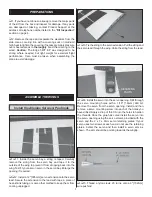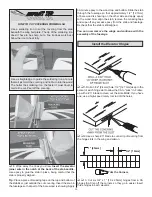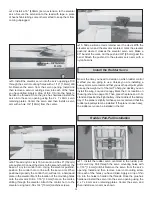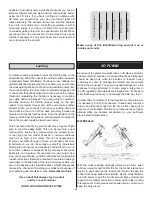
15
❏
8. Working from the end of the string inside the fuselage,
pass the string through a crimp, through the rigging coupler
and back through the crimp. Squeeze the crimp with a pliers
to secure the string in the crimp. Apply a drop of thin CA to
the crimp.
❏
9. Attach the clevises to the rudder servo horn in the holes
3/4" [19mm] from the center.
❏
10. Pull the pull-pull string out of the fuselage aft end
so that the string is tight. Pass the string through a crimp,
through the rigging coupler and back through the crimp.
Attach the clevis to the nylon torque rod horn on the rudder
and tape the string to the side of the fuselage. Repeat on the
other side of the fuselage.
❏
11. With the rudder and the rudder servo arm centered,
pull the string tight at the rudder and squeeze the crimps to
secure the strings.
Rudder Servo Installation in the Tail
❏
1. Cut the covering away from the upper opening on the
right side, in the rear of the fuselage for the rudder servo.
❏
2. Install a 16" [406mm] servo extension on the rudder
servo. Secure the extension to the lead with tape, a piece of
heat-shrink tubing or some other method to keep them from
coming unplugged.
❏
3. Install the rudder servo into the servo opening. Drill
through the servo mounting holes with a 1/16" [1.6mm] drill
bit. Remove the servo from the servo opening. Install and
then remove a servo mounting screw into each of the holes
you have drilled. Apply a drop of thin CA into the holes to
harden the threads. Once the glue has hardened install the
servo into the servo opening using the 2 x 7 x 9mm servo
retaining plates. Center the servo, and then install a servo
arm as shown.
❏
4. Thread a nylon clevis 16 turns onto a 2-56 x 6"
[150mm] wire pushrod. Connect the clevis to the second
hole from the base of a nylon control horn. Using the rudder
pushrod, position the control horn in line with the servo arm.










































